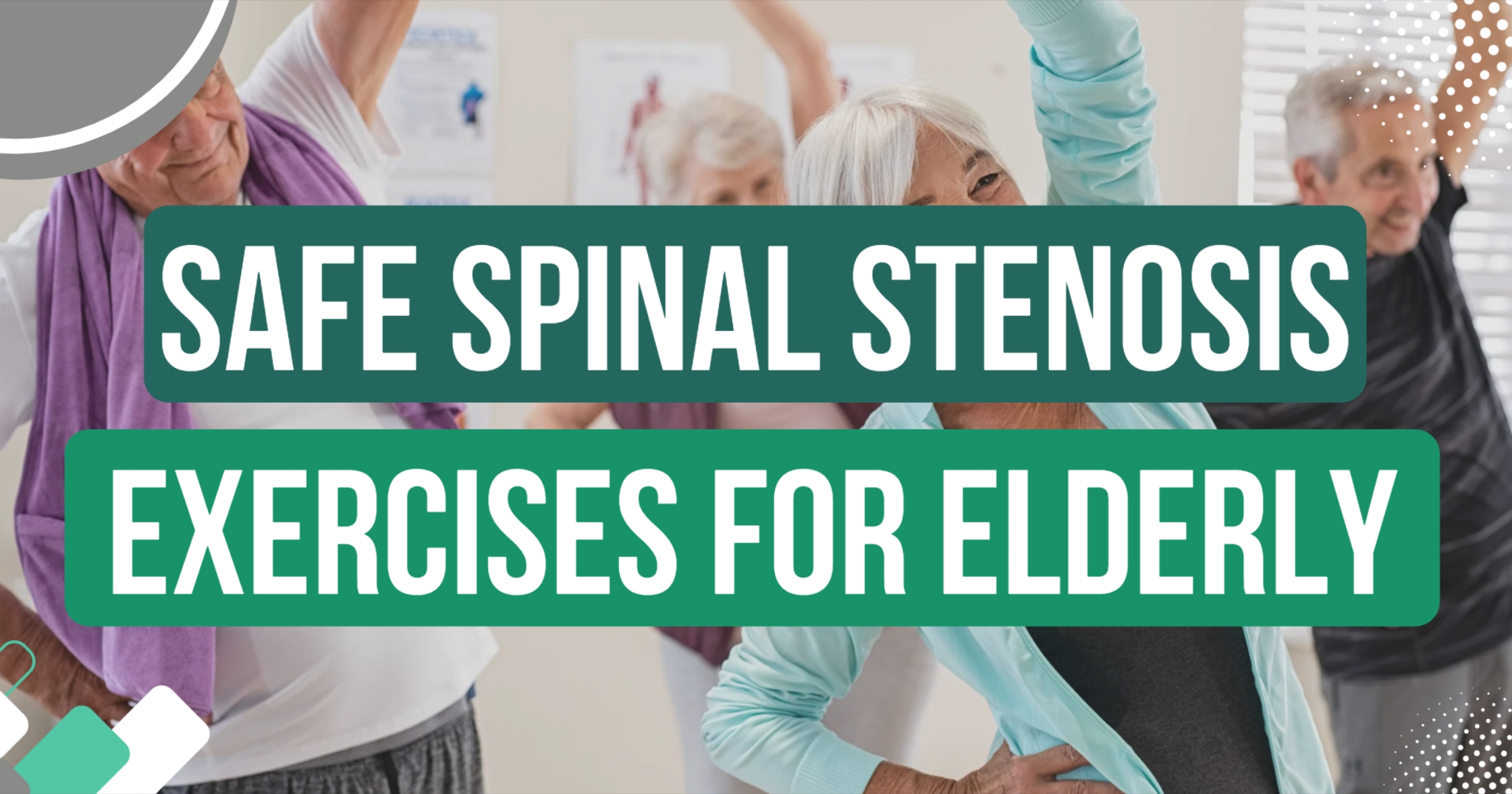
3 Safe Spinal Stenosis Exercises for Elderly You Can Do Pain Free!
After 10 years of treating spinal stenosis, here are three safe and efficient standing exercises I consistently prescribe: Suspension Trainer Squats, Suspension Trainer Lunges, and Suspension Trainer Rows. These exercises improve mobility, reduce pain, and build strength without requiring you to get on the floor—making them ideal for seniors and older adults dealing with stenosis-related leg pain and walking difficulties.
Why Exercise Is Essential for Spinal Stenosis
Spinal stenosis affects approximately 11% of older adults, making it one of the most common causes of leg pain and difficulty walking in people over 60. The condition occurs when the spaces within your spine narrow, putting pressure on the nerves that run through them. This can cause sciatica. If you are unsure if you have sciatica check out my quiz, which can help you figure out if you have sciatica from stenosis.
Here's the good news: exercise has been proven time and time again to be one of the most effective treatments for spinal stenosis. In my 10+ years as a physical therapist, I've seen countless patients improve their walking tolerance, reduce their pain, and avoid surgery through consistent, targeted exercise.
If you like the exercise below, check out this PDF, which includes instructions for spinal stenosis exercises and is an easy-to-follow program you can do on your own!
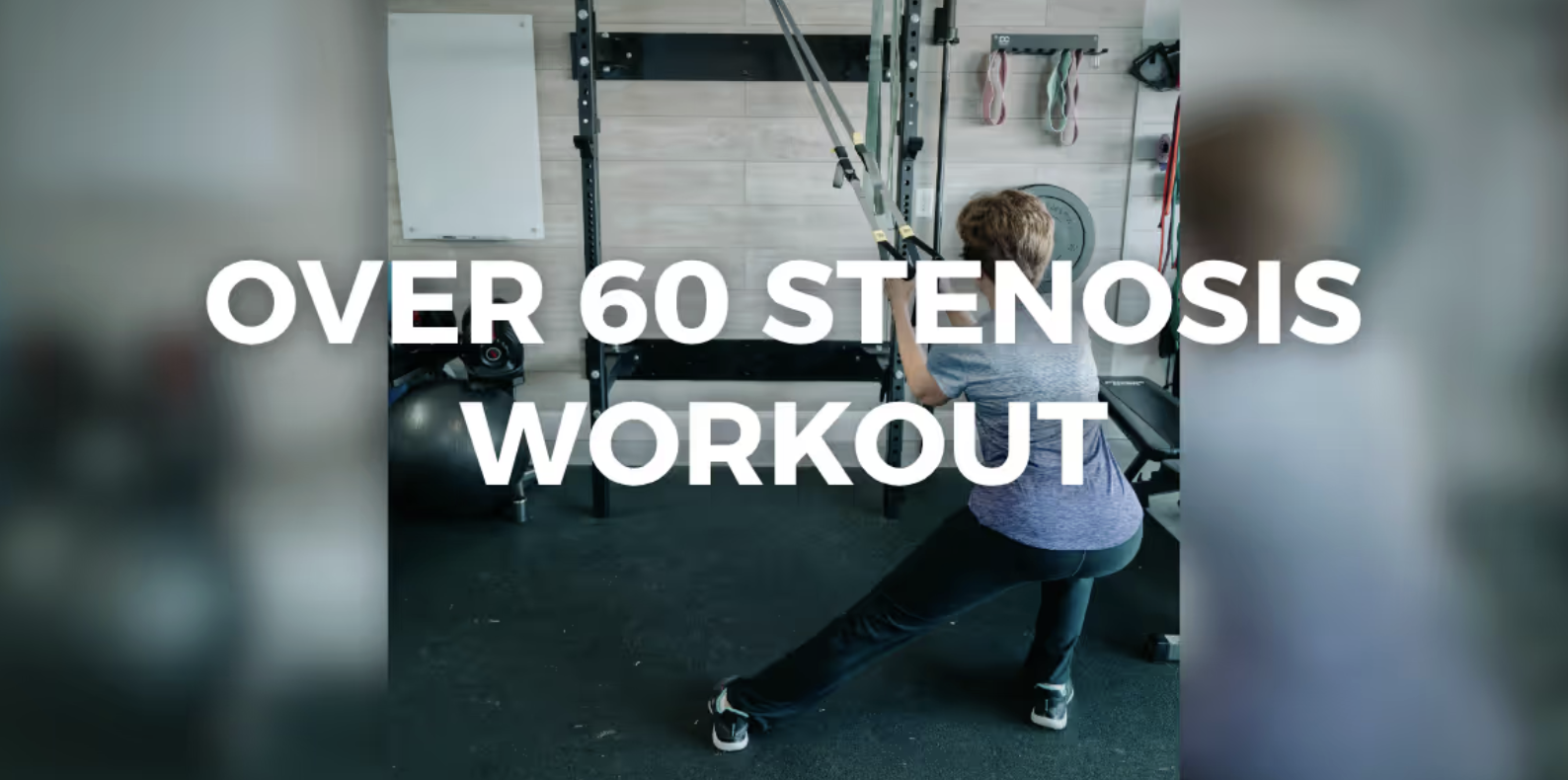
The 3 Best Exercises for Spinal Stenosis
Exercise 1: Suspension Trainer Squats
Best for: Building leg and hip strength to improve walking tolerance and reduce leg pain
Why this works: Squats are a flexion-based exercise, and flexion is your friend when you have stenosis. This position opens up the space in your spine where the nerves exit, providing immediate relief. At the same time, you're building the leg strength necessary to walk longer and stand with less discomfort.

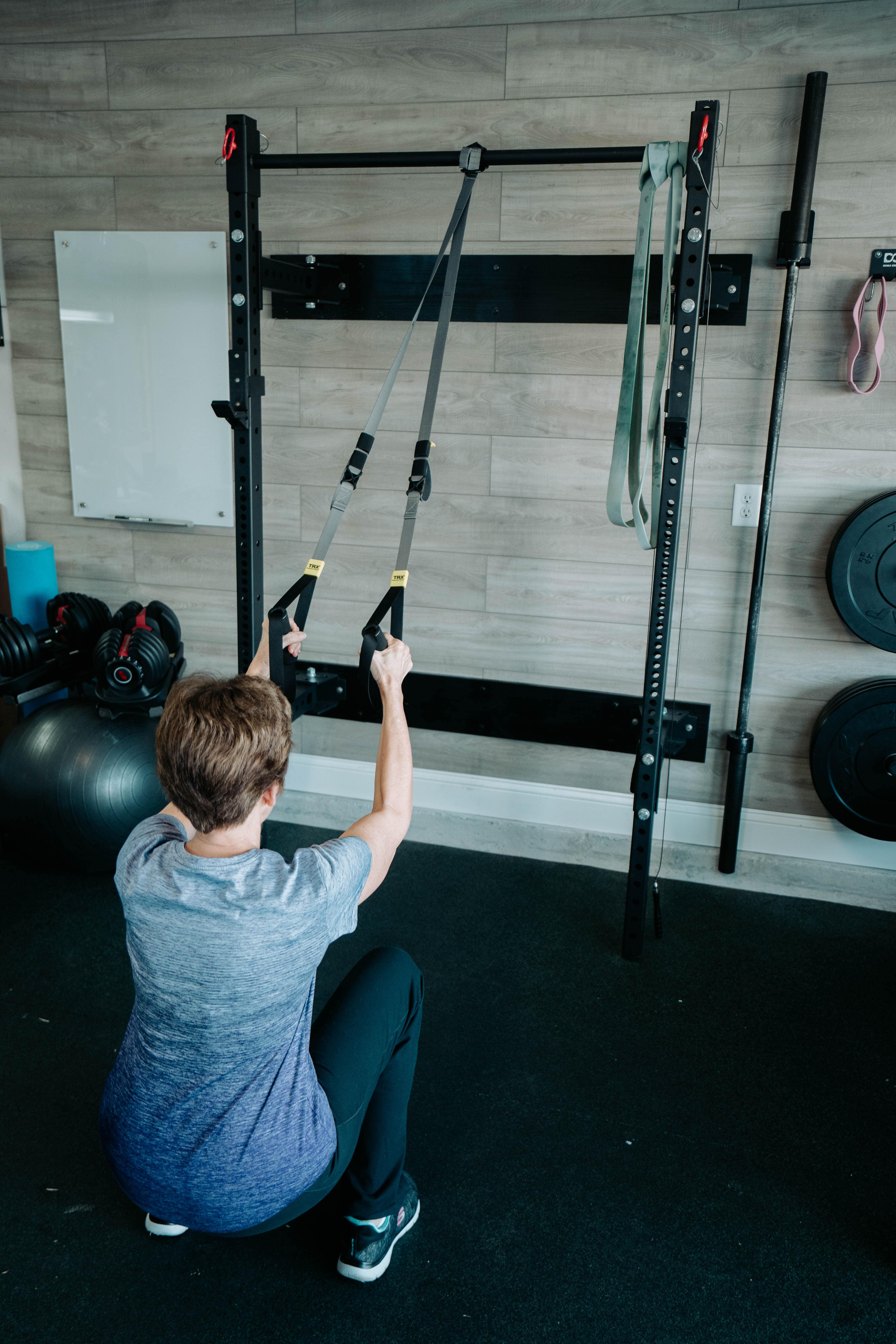
How to do the exercise:
- Grab both handles of the suspension trainer with a firm grip
- Step back so there's tension in the straps
- Position your feet about shoulder-width apart
- Lean back slightly while gripping the handles—your arms will have a slight bend
- Lower yourself down by bending your knees, as if sitting back into a chair
- Think about going DOWN toward the ground, not sticking your butt out
- Go as low as comfortable, then push through your heels to return to standing
- Use your arms as much as needed for support
Expert tip: The deeper you go, the more it works your hips and lower back. As you get comfortable, try going lower. You can vary the depth and angle of your body to increase the challenge.
What you should feel: Your thighs and glutes working. You may feel pressure in your lower back, but this should not cause nerve pain down your legs. If you feel leg pain, don't go as deep and sit down to rest.
Dosage: Start with two sets of 12 repetitions.
Common mistake I see: People try to go too deep too quickly. Start with a comfortable range and build up over 2-3 weeks. Your body will adapt.
Exercise 2: Suspension Trainer Backward Lunges
Best for: Improving walking mechanics, hip flexor length, and single-leg strength.
Why this works: Walking becomes difficult with stenosis because your hips and legs lose strength and flexibility. Backward lunges safely rebuild that strength while keeping you in an upright, supported position. This exercise directly translates to improved walking ability.
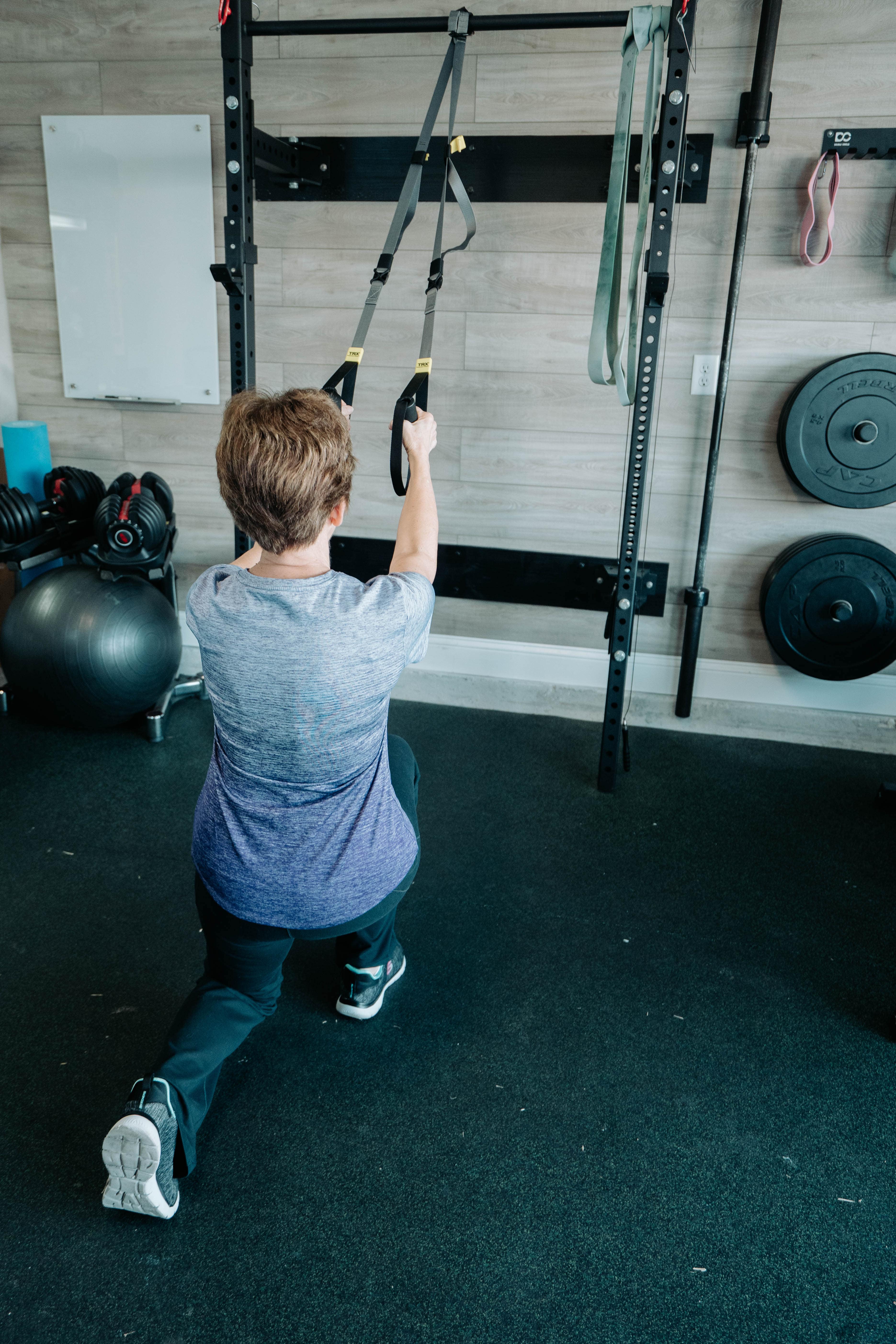
How to do the exercise:
- Grab both handles and closer to the device than you think.
- Start with your feet together, standing tall
- Take a large step backward with one foot—the bigger the step, the better the stretch
- Gather your balance while holding the handles
- Bend both knees, bringing your back knee toward the ground - but not touching it!
- The goal isn't to touch the ground but to feel your front leg working and back leg stretching
- Push through your front heel to return to the starting position
- Bring your feet back together, then step back with the other leg
Expert tip: Use your arms as much as you need to. This is a hard exercise, so if your legs feel tired or sore, that’s normal.
What you should feel: The front leg (the one you're standing on) should be working hard. You should feel a stretch in the front of the hip on the back leg. Some lower back pressure is normal, but stop if you think nerve pain is traveling down your leg.
Dosage: Start with two sets of 8-10 repetitions on each leg. Rest between sets.
Important consideration: This exercise can initially cause mild back stiffness since you're working the muscles that extend your back and hips. If you need relief, perform a suspension trainer squat between sets—the flexion will counteract any discomfort from the extension.
Exercise 3: Suspension Trainer Rows
Best for: Building upper back and core strength to improve posture and reduce forward lean
Why this works: Many people with stenosis want to improve their posture and strengthen the muscles that fight gravity. Rows strengthen the muscles that help you stand taller, which improves your overall ability to fight gravity over time. That said, here is what I think about posture and pain!
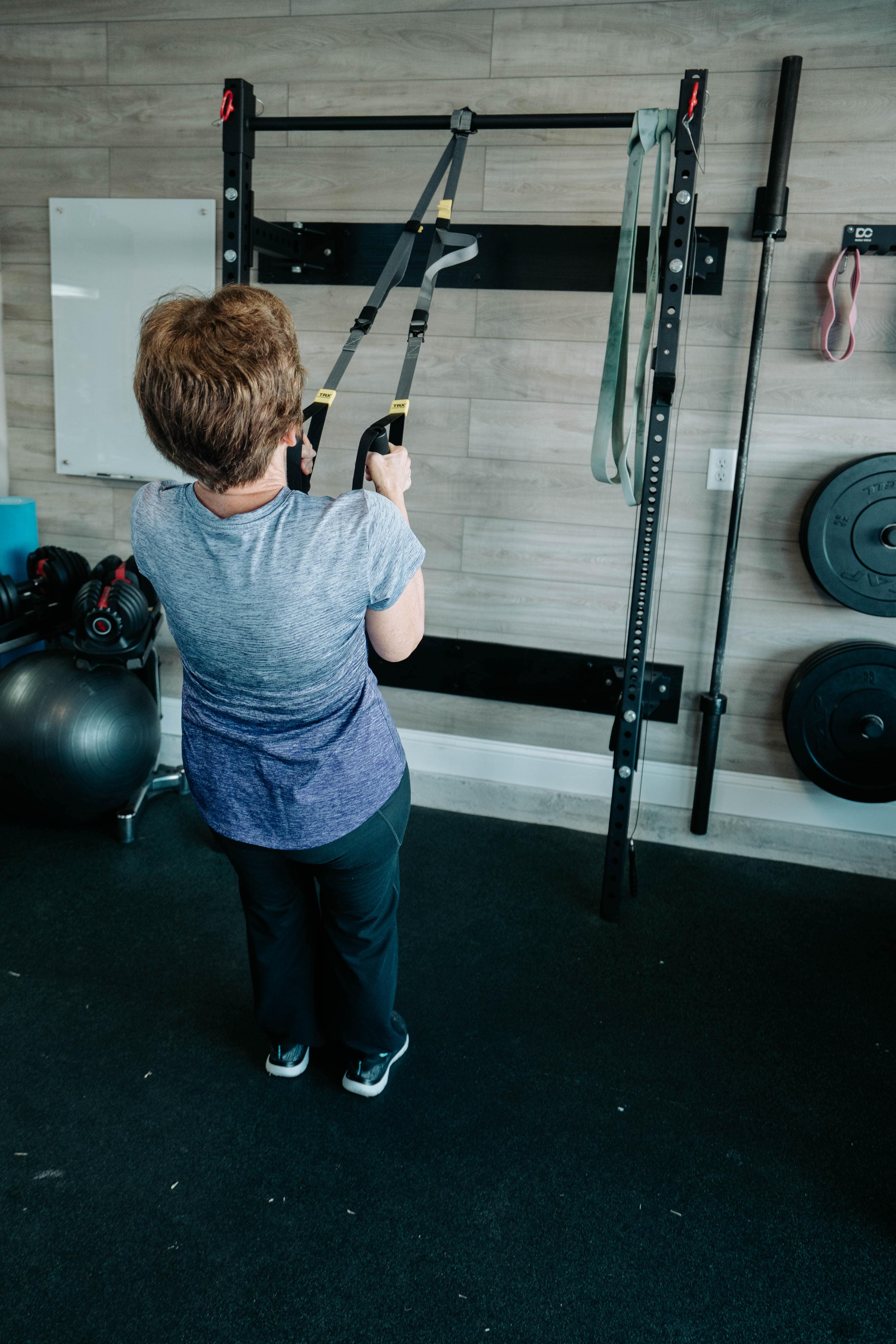
How to do the exercise:
- Stand facing the door where your suspension trainer is anchored
- Hold both handles with your arms
- Step your feet closer to the door so your body has a slight backward lean
- Keep your body straight like a plank
- Pull yourself toward the handles by bending your elbows and bringing them to your sides
- Think about pinching your shoulder blades together as you row up
- Slowly lower yourself back to the starting position with control
Expert tip: The closer your feet are to the door, the harder this becomes. Start with your feet farther back (a more upright body position) and progress over time. Maintain good posture throughout—keep your chin slightly tucked and don't let your hips sag.
What you should feel: Your upper back and arm muscles.
Dosage: Start with two sets of 12 repetitions
Common mistake I see: people pull back too far. Just stop when your elbows are at your side.
The Problem With Traditional Stenosis Exercises
You've probably seen videos or articles recommending exercises like pelvic tilts or knee-to-chest stretches for stenosis. While these CAN work, they are unlikely to move the needle on your walking ability or pain. Here are my issues with pelvic tilts and knees to chest:
- Getting on the floor is hard! Oftentimes, you have other issues going on, too! Such as general mobility challenges, which make getting down and back up from the floor difficult.
- Short-term relief only: Exercises done lying down may feel good in the moment, but they don't prepare your body for what you actually need to do—stand, walk, and move through your daily life.
- Missing the strength component: Many traditional exercises focus only on flexibility, but they don't build the strength necessary to improve your walking tolerance.
That's why I'm going to show you three exercises you can do standing that not only improve mobility and pain but are entirely safe for seniors and older adults. Even better, these exercises use a suspension trainer, which provides support and lets you control the difficulty level precisely.
If you are looking for a whole 8-week progression and much more information on spinal stenosis, you should check out my book! It covers common questions, specific exercises and stretches, and the exact formula I use to help those with stenos not only get better but stay better.
What Is a Suspension Trainer and Why Use It?
A suspension trainer is a set of adjustable straps with handles that attach to a door or sturdy anchor point. It’s super safe and easy to set up! Here’s the one I recommend:
I earn commission as an Amazon Affiliate
After 10 years of treating patients with spinal stenosis, I haven't found a better way to help older adults improve strength with perfect form and fear of falling! The suspension trainer allows you to:
- Control how much support you need from your arms with every exercise
- Exercise standing up, which directly transfers to improved walking and daily activities
- Feel secure and stable, reducing fear of falling
- Get into a broader range of motion to get stronger, faster!
Important: Make sure someone helps you install the suspension trainer correctly on a door or sturdy anchor point. While I've never seen one break, proper installation is essential for safety.
How to Structure Your Stenosis Exercise Routine
Frequency: Perform these exercises 3 times per week.
Listen to your body: Some muscle soreness is normal. However, increased leg pain, tingling, or numbness that lasts more than a few minutes after stopping is a signal to modify the exercise or rest.
If you are having a hard time dialing it in or figuring it out. Check out my book on stenosis. It goes into great detail about stenosis, the progression of exercises, and how to improve nerve health.
The Rule to Follow: Exercises should cause zero nerve pain down your leg. Back pressure and muscle soreness are normal, but if you feel pain radiating into your glutes, legs, or feet, stop and sit down until the pain resolves.
What Else Can You Do to Improve Stenosis Symptoms?
Beyond these exercises, several other approaches can help manage your stenosis:
Heating Pads: Heat is excellent for reducing muscle tension after walking for an extended period. It won’t change the structure in your back, but it does feel good. Apply a heating pad for 15-20 minutes before exercising or whenever you feel stiff. Always use a barrier, like a towel, between your skin and the heat source to avoid burns.
TENS unit: A TENS unit sends mild electrical pulses through your skin that can reduce pain signals. Place the electrode pads over your lower back, glutes, or areas of leg pain. Use for 15-20 minutes at a time. Here’s a video on how to apply it correctly.
Traction: I've seen patients experience significant relief with traction. In fact, it’s safe and effective. This is exactly how I would do it in your home!
Walking Poles: I have multiple people who do well with purchasing some walking poles when they want to continue walking but are having some pain. And, they are not ready to transition to a cane or walker. They allow you to walk further and more comfortably because they are slightly pitched forward. Here’s a solid pick!
When to Seek Professional Help
Consider seeing a physical therapist if you experience:
- No improvement after 4-6 weeks of consistent exercise
- Worsening weakness in your legs or feet
- Difficulty controlling your bowel or bladder (seek immediate medical attention)
- Numbness in the groin area
- Pain so severe that it prevents you from walking even short distances
Frequently Asked Questions
How long before I notice improvement?
Most patients notice some improvement within 2 weeks of consistent exercise.
Can I do these exercises every day?
I recommend 2-3 strength-training sessions per week. Your muscles need rest days to recover. However, you should walk every day and perform mobility exercises daily.
Will these exercises cure my stenosis?
These exercises won't remove the arthritis or the bone changes that are causing stenosis. Still, they can significantly improve your symptoms by strengthening the muscles that support your spine and enhancing your nerve tolerance. Many of my patients avoid surgery by staying consistent with exercise.
What if I don't have a suspension trainer?
While I strongly recommend a suspension trainer. However, most gyms have suspension trainers, so you can check there as well!
Should I stop exercising if I have pain?
Some discomfort and muscle soreness are normal. However, sharp pain, increased leg numbness, or pain radiating farther down your leg are signals to stop and rest. When in doubt, consult with a physical therapist.
The Bottom Line
Spinal stenosis doesn't have to control your life. Through consistent, targeted exercise using a suspension trainer, you can:
- Reduce leg pain and improve walking tolerance
- Build the strength necessary to stay independent
- Potentially avoid surgery or delay it significantly
- Exercise safely without the fear of falling or the need to get on the floor
The three exercises I've shared, suspension trainer squats, backward lunges, and rows, form the foundation of what I use with my older adult patients dealing with stenosis. Combined with daily walking and the pain relief strategies mentioned, you have a comprehensive approach to managing your condition. Want a complete, structured program? Our Pain-Free Walking eBook takes you through everything step-by-step.
Remember, building resilience takes time. Start where you are, stay consistent, and trust the process. Your body is capable of remarkable improvement when you give it the right tools.
Ready to Take Control of Your Stenosis?
If you want more guidance on managing spinal stenosis, including additional exercises, stretches, and pain relief strategies:
- Purchase my book on spinal stenosis on Amazon!
- Watch detailed exercise demonstrations on my YouTube channel, The Resilient Spine
- Schedule an online consultation to talk about whatever you have questions about!
Remember: While these exercises help many of my patients, everyone's situation is unique. When in doubt, seek professional guidance for the safest, most effective treatment approach.
Summary
Standing suspension trainer exercises are a safe and effective way for seniors and older adults with spinal stenosis to reduce pain, improve mobility, and build strength, without getting on the floor. In this blog, I share my top three go-to moves: squats, backward lunges, and rows. These exercises not only target the root causes of walking difficulties and leg pain but also help you stay active, independent, and confident in your daily life.
Disclaimer: This article is for educational purposes only and should not replace professional medical advice. Always consult with your healthcare provider before starting a new exercise program, especially if you have been diagnosed with spinal stenosis or other spine conditions.
After 10 years of treating spinal stenosis, here are three safe and efficient standing exercises I consistently prescribe: Suspension Trainer Squats, Suspension Trainer Lunges, and Suspension Trainer Rows. These exercises improve mobility, reduce pain, and build strength without requiring you to get on the floor—making them ideal for seniors and older adults dealing with stenosis-related leg pain and walking difficulties.
Why Exercise Is Essential for Spinal Stenosis
Spinal stenosis affects approximately 11% of older adults, making it one of the most common causes of leg pain and difficulty walking in people over 60. The condition occurs when the spaces within your spine narrow, putting pressure on the nerves that run through them. This can cause sciatica. If you are unsure if you have sciatica check out my quiz, which can help you figure out if you have sciatica from stenosis.
Here's the good news: exercise has been proven time and time again to be one of the most effective treatments for spinal stenosis. In my 10+ years as a physical therapist, I've seen countless patients improve their walking tolerance, reduce their pain, and avoid surgery through consistent, targeted exercise.
If you like the exercise below, check out this PDF, which includes instructions for spinal stenosis exercises and is an easy-to-follow program you can do on your own!

The 3 Best Exercises for Spinal Stenosis
Exercise 1: Suspension Trainer Squats
Best for: Building leg and hip strength to improve walking tolerance and reduce leg pain
Why this works: Squats are a flexion-based exercise, and flexion is your friend when you have stenosis. This position opens up the space in your spine where the nerves exit, providing immediate relief. At the same time, you're building the leg strength necessary to walk longer and stand with less discomfort.


How to do the exercise:
- Grab both handles of the suspension trainer with a firm grip
- Step back so there's tension in the straps
- Position your feet about shoulder-width apart
- Lean back slightly while gripping the handles—your arms will have a slight bend
- Lower yourself down by bending your knees, as if sitting back into a chair
- Think about going DOWN toward the ground, not sticking your butt out
- Go as low as comfortable, then push through your heels to return to standing
- Use your arms as much as needed for support
Expert tip: The deeper you go, the more it works your hips and lower back. As you get comfortable, try going lower. You can vary the depth and angle of your body to increase the challenge.
What you should feel: Your thighs and glutes working. You may feel pressure in your lower back, but this should not cause nerve pain down your legs. If you feel leg pain, don't go as deep and sit down to rest.
Dosage: Start with two sets of 12 repetitions.
Common mistake I see: People try to go too deep too quickly. Start with a comfortable range and build up over 2-3 weeks. Your body will adapt.
Exercise 2: Suspension Trainer Backward Lunges
Best for: Improving walking mechanics, hip flexor length, and single-leg strength.
Why this works: Walking becomes difficult with stenosis because your hips and legs lose strength and flexibility. Backward lunges safely rebuild that strength while keeping you in an upright, supported position. This exercise directly translates to improved walking ability.

How to do the exercise:
- Grab both handles and closer to the device than you think.
- Start with your feet together, standing tall
- Take a large step backward with one foot—the bigger the step, the better the stretch
- Gather your balance while holding the handles
- Bend both knees, bringing your back knee toward the ground - but not touching it!
- The goal isn't to touch the ground but to feel your front leg working and back leg stretching
- Push through your front heel to return to the starting position
- Bring your feet back together, then step back with the other leg
Expert tip: Use your arms as much as you need to. This is a hard exercise, so if your legs feel tired or sore, that’s normal.
What you should feel: The front leg (the one you're standing on) should be working hard. You should feel a stretch in the front of the hip on the back leg. Some lower back pressure is normal, but stop if you think nerve pain is traveling down your leg.
Dosage: Start with two sets of 8-10 repetitions on each leg. Rest between sets.
Important consideration: This exercise can initially cause mild back stiffness since you're working the muscles that extend your back and hips. If you need relief, perform a suspension trainer squat between sets—the flexion will counteract any discomfort from the extension.
Exercise 3: Suspension Trainer Rows
Best for: Building upper back and core strength to improve posture and reduce forward lean
Why this works: Many people with stenosis want to improve their posture and strengthen the muscles that fight gravity. Rows strengthen the muscles that help you stand taller, which improves your overall ability to fight gravity over time. That said, here is what I think about posture and pain!

How to do the exercise:
- Stand facing the door where your suspension trainer is anchored
- Hold both handles with your arms
- Step your feet closer to the door so your body has a slight backward lean
- Keep your body straight like a plank
- Pull yourself toward the handles by bending your elbows and bringing them to your sides
- Think about pinching your shoulder blades together as you row up
- Slowly lower yourself back to the starting position with control
Expert tip: The closer your feet are to the door, the harder this becomes. Start with your feet farther back (a more upright body position) and progress over time. Maintain good posture throughout—keep your chin slightly tucked and don't let your hips sag.
What you should feel: Your upper back and arm muscles.
Dosage: Start with two sets of 12 repetitions
Common mistake I see: people pull back too far. Just stop when your elbows are at your side.
The Problem With Traditional Stenosis Exercises
You've probably seen videos or articles recommending exercises like pelvic tilts or knee-to-chest stretches for stenosis. While these CAN work, they are unlikely to move the needle on your walking ability or pain. Here are my issues with pelvic tilts and knees to chest:
- Getting on the floor is hard! Oftentimes, you have other issues going on, too! Such as general mobility challenges, which make getting down and back up from the floor difficult.
- Short-term relief only: Exercises done lying down may feel good in the moment, but they don't prepare your body for what you actually need to do—stand, walk, and move through your daily life.
- Missing the strength component: Many traditional exercises focus only on flexibility, but they don't build the strength necessary to improve your walking tolerance.
That's why I'm going to show you three exercises you can do standing that not only improve mobility and pain but are entirely safe for seniors and older adults. Even better, these exercises use a suspension trainer, which provides support and lets you control the difficulty level precisely.
If you are looking for a whole 8-week progression and much more information on spinal stenosis, you should check out my book! It covers common questions, specific exercises and stretches, and the exact formula I use to help those with stenos not only get better but stay better.
What Is a Suspension Trainer and Why Use It?
A suspension trainer is a set of adjustable straps with handles that attach to a door or sturdy anchor point. It’s super safe and easy to set up! Here’s the one I recommend:
I earn commission as an Amazon Affiliate
After 10 years of treating patients with spinal stenosis, I haven't found a better way to help older adults improve strength with perfect form and fear of falling! The suspension trainer allows you to:
- Control how much support you need from your arms with every exercise
- Exercise standing up, which directly transfers to improved walking and daily activities
- Feel secure and stable, reducing fear of falling
- Get into a broader range of motion to get stronger, faster!
Important: Make sure someone helps you install the suspension trainer correctly on a door or sturdy anchor point. While I've never seen one break, proper installation is essential for safety.
How to Structure Your Stenosis Exercise Routine
Frequency: Perform these exercises 3 times per week.
Listen to your body: Some muscle soreness is normal. However, increased leg pain, tingling, or numbness that lasts more than a few minutes after stopping is a signal to modify the exercise or rest.
If you are having a hard time dialing it in or figuring it out. Check out my book on stenosis. It goes into great detail about stenosis, the progression of exercises, and how to improve nerve health.
The Rule to Follow: Exercises should cause zero nerve pain down your leg. Back pressure and muscle soreness are normal, but if you feel pain radiating into your glutes, legs, or feet, stop and sit down until the pain resolves.
What Else Can You Do to Improve Stenosis Symptoms?
Beyond these exercises, several other approaches can help manage your stenosis:
Heating Pads: Heat is excellent for reducing muscle tension after walking for an extended period. It won’t change the structure in your back, but it does feel good. Apply a heating pad for 15-20 minutes before exercising or whenever you feel stiff. Always use a barrier, like a towel, between your skin and the heat source to avoid burns.
TENS unit: A TENS unit sends mild electrical pulses through your skin that can reduce pain signals. Place the electrode pads over your lower back, glutes, or areas of leg pain. Use for 15-20 minutes at a time. Here’s a video on how to apply it correctly.
Traction: I've seen patients experience significant relief with traction. In fact, it’s safe and effective. This is exactly how I would do it in your home!
Walking Poles: I have multiple people who do well with purchasing some walking poles when they want to continue walking but are having some pain. And, they are not ready to transition to a cane or walker. They allow you to walk further and more comfortably because they are slightly pitched forward. Here’s a solid pick!
When to Seek Professional Help
Consider seeing a physical therapist if you experience:
- No improvement after 4-6 weeks of consistent exercise
- Worsening weakness in your legs or feet
- Difficulty controlling your bowel or bladder (seek immediate medical attention)
- Numbness in the groin area
- Pain so severe that it prevents you from walking even short distances
Frequently Asked Questions
How long before I notice improvement?
Most patients notice some improvement within 2 weeks of consistent exercise.
Can I do these exercises every day?
I recommend 2-3 strength-training sessions per week. Your muscles need rest days to recover. However, you should walk every day and perform mobility exercises daily.
Will these exercises cure my stenosis?
These exercises won't remove the arthritis or the bone changes that are causing stenosis. Still, they can significantly improve your symptoms by strengthening the muscles that support your spine and enhancing your nerve tolerance. Many of my patients avoid surgery by staying consistent with exercise.
What if I don't have a suspension trainer?
While I strongly recommend a suspension trainer. However, most gyms have suspension trainers, so you can check there as well!
Should I stop exercising if I have pain?
Some discomfort and muscle soreness are normal. However, sharp pain, increased leg numbness, or pain radiating farther down your leg are signals to stop and rest. When in doubt, consult with a physical therapist.
The Bottom Line
Spinal stenosis doesn't have to control your life. Through consistent, targeted exercise using a suspension trainer, you can:
- Reduce leg pain and improve walking tolerance
- Build the strength necessary to stay independent
- Potentially avoid surgery or delay it significantly
- Exercise safely without the fear of falling or the need to get on the floor
The three exercises I've shared, suspension trainer squats, backward lunges, and rows, form the foundation of what I use with my older adult patients dealing with stenosis. Combined with daily walking and the pain relief strategies mentioned, you have a comprehensive approach to managing your condition. Want a complete, structured program? Our Pain-Free Walking eBook takes you through everything step-by-step.
Remember, building resilience takes time. Start where you are, stay consistent, and trust the process. Your body is capable of remarkable improvement when you give it the right tools.
Ready to Take Control of Your Stenosis?
If you want more guidance on managing spinal stenosis, including additional exercises, stretches, and pain relief strategies:
- Purchase my book on spinal stenosis on Amazon!
- Watch detailed exercise demonstrations on my YouTube channel, The Resilient Spine
- Schedule an online consultation to talk about whatever you have questions about!
Remember: While these exercises help many of my patients, everyone's situation is unique. When in doubt, seek professional guidance for the safest, most effective treatment approach.
Summary
Standing suspension trainer exercises are a safe and effective way for seniors and older adults with spinal stenosis to reduce pain, improve mobility, and build strength, without getting on the floor. In this blog, I share my top three go-to moves: squats, backward lunges, and rows. These exercises not only target the root causes of walking difficulties and leg pain but also help you stay active, independent, and confident in your daily life.
Disclaimer: This article is for educational purposes only and should not replace professional medical advice. Always consult with your healthcare provider before starting a new exercise program, especially if you have been diagnosed with spinal stenosis or other spine conditions.


%20Blog%20thumbnails%204.avif)
%20Blog%20thumbnails.avif)
